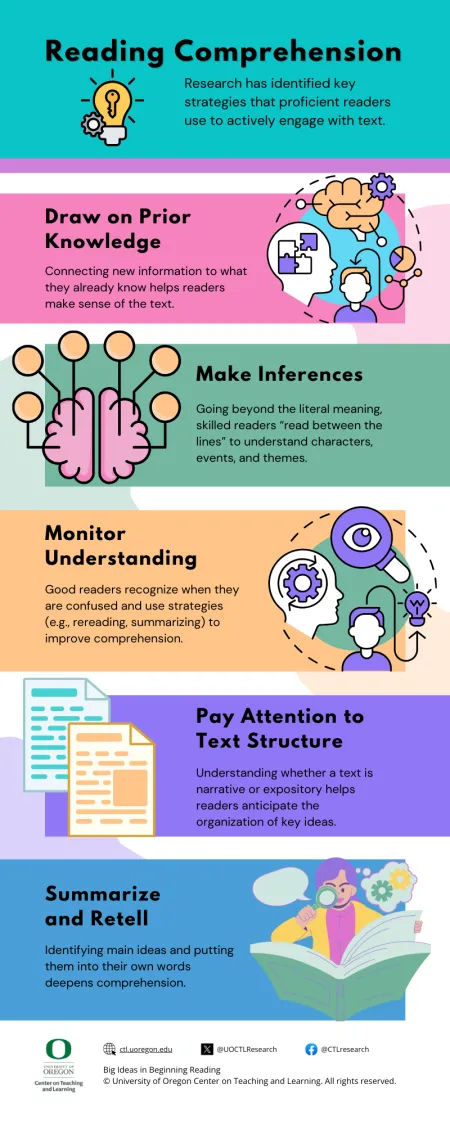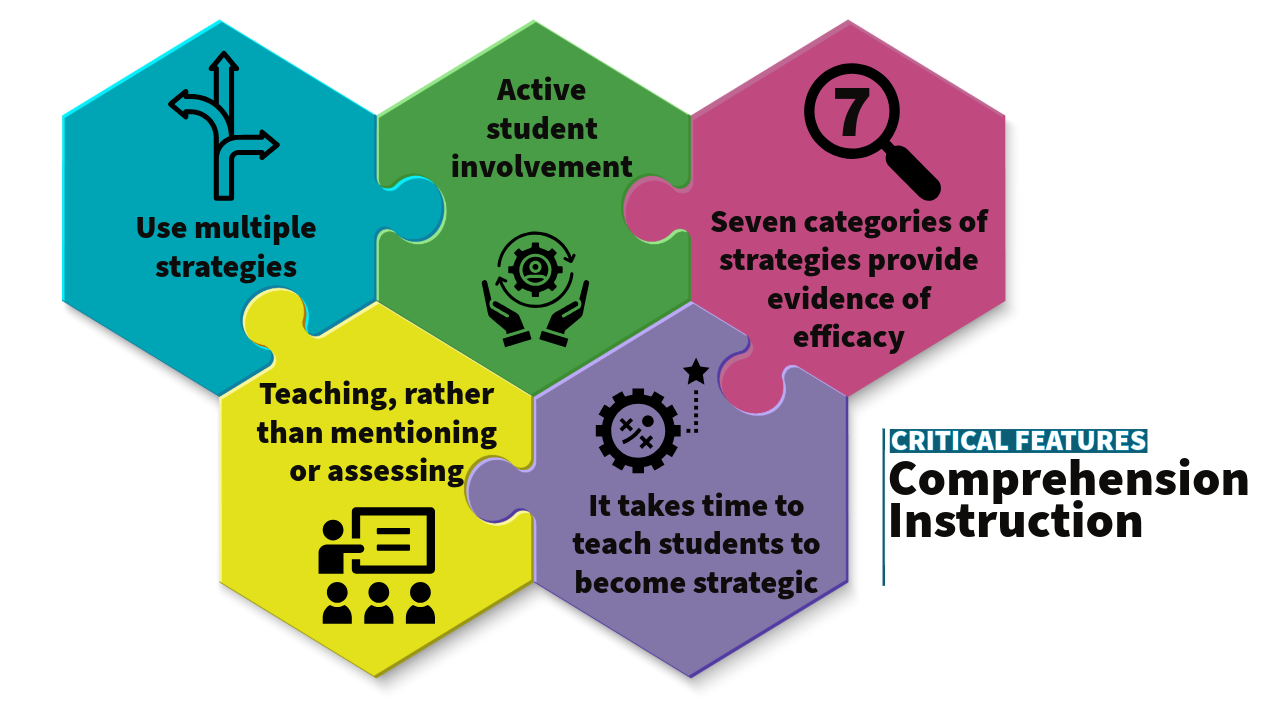The ability to understand, interpret, and gain meaning from written text. Comprehension is the ultimate goal of reading.
Reading comprehension transforms decoding into meaningful learning. When students comprehend what they read, they can analyze, synthesize, and apply information. On this page you will learn what comprehension is, how it develops, and the teaching practices that help students become thoughtful, engaged readers. Teachers and parents can support comprehension through strategy instruction, purposeful discussions, and intentional text selection.
Overview
Mini Mastery - Comprehension
What is Reading Comprehension?
Comprehension is the ultimate goal of reading. It is the ability to understand, interpret, and gain meaning from written text. Without comprehension, reading is merely decoding—word recognition without understanding. Strong comprehension skills allow students to absorb, analyze, and apply information, making reading a tool for lifelong learning.
Reading comprehension is an active and intentional process in which the reader interacts with the text to extract and construct meaning. According to the Rand Reading Study Group (2002), comprehension is shaped by the interaction of three key elements:
- The Reader: A reader’s background knowledge, vocabulary, decoding skills, and motivation all influence comprehension.
- The Text: The structure, complexity, and clarity of a text impact how easily a reader can understand it.
- The Activity: The purpose for reading, the questions asked, and the comprehension strategies used affect how deeply a reader engages with the text.
Each of these elements interacts within a broader socio-cultural context, where factors such as language background, prior experiences, and classroom instruction play a role in comprehension development.
Why Should We Focus on Reading Comprehension?
Teachers play a vital role in fostering students’ comprehension skills. Research has shown that effective comprehension instruction enhances students’ ability to understand, retain, and apply what they read. Strong instruction also helps students articulate their thoughts—both verbally and in writing—enabling them to engage in meaningful discussions about texts.
What does Effective Reading Comprehension Instruction Look like?
According to the National Reading Panel (2000), the most effective comprehension instruction includes:
- Explicit Strategy Instruction: Teaching students how to ask questions, summarize, and monitor comprehension.
- Question Answering and Generation: Encouraging students to answer and create different types of questions (literal, inferential, evaluative).
- Graphic Organizers: Using tools like story maps and semantic organizers to help students visualize ideas.
- Comprehension Monitoring: Teaching students to recognize when they don’t understand and apply fix-up strategies.
- Summarization: Helping students identify key points and synthesize information.
- Cooperative Learning: Encouraging peer discussions and collaborative thinking to deepen understanding.
More recently, the National Center for Educational Evaluation and Regional Assistance (2010) has said that the most effective comprehension instruction:
- Teaches students how to use research-based reading comprehension strategies individually or in combination using a gradual release of responsibility.
- Teaches students to identify and use a text’s organizational structure to comprehend, learn, and remember content.
- Guides students through focused, high-quality discussion on the meaning of text using questions that prompt them to think deeply about what they are reading.
- Selects texts purposefully to support comprehension development by choosing texts with a depth of ideas and information, at a difficulty level appropriate for students’, and that supports the purpose of instruction.
- Establishes an engaging and motivating context in which to teach comprehension by helping students to discover the purpose and benefits of reading, experience success and choice, and collaborate with peers.
How Do We Support Reading Comprehension in the Classroom?
Teachers can enhance comprehension through structured, scaffolded instruction:
- Before Reading: Set a purpose, activate background knowledge, and preview the text.
- During Reading: Encourage questioning, identify text structures, and make inferences.
- After Reading: Summarize, discuss key ideas, and apply new knowledge.
Reading comprehension should be taught explicitly and systematically at all grade levels, not just the early grades. In the early years, oral language, listening comprehension, and text structure awareness build a strong foundation. As students develop reading fluency, instruction should emphasize critical thinking, text analysis, and knowledge-building through engagement with a variety of texts. Importantly, the old-fashioned idea of reading to learn transitioning to learning to read has been shown to be false. Younger readers can read to learn new content, just as older readers can learn to read in new ways and for new purposes. By intentionally teaching comprehension strategies and providing rich reading experiences throughout the grades, educators can help students become skilled, thoughtful, and engaged readers.
Reading Comprehension Key Strategies
Research has identified key strategies that proficient readers use to actively engage with text.
Draw on Prior Knowledge
Connecting new information to what they already know helps readers make sense of the text.
Make Inferences
Going beyond the literal meaning, skilled readers “read between the lines” to understand characters, events, and themes.
Monitor Understanding
Good readers recognize when they are confused and use strategies (e.g., rereading, summarizing) to improve comprehension.
Pay Attention to Text Structure
Understanding whether a text is narrative or expository helps readers anticipate the organization of key ideas.
Summarize and Retell
Identifying main ideas and putting them into their own words deepens comprehension.

Download Infographic
Role in Reading
Comprehension is the reason we read. It allows students to make sense of text and use reading as a tool for learning and thinking. Skilled readers use background knowledge, vocabulary, and strategies to make meaning from a wide variety of texts. Teachers build comprehension by modeling strategies like questioning, summarizing, and monitoring understanding—before, during, and after reading.
Effective reading comprehension instruction, crucial from kindergarten through high school and beyond, requires teachers to explicitly model and teach a variety of strategies like summarizing and inferring. Students need active practice with these strategies in diverse texts to become independent, thoughtful readers.
Critical Features of Comprehension Instruction

Use multiple strategies: Instruction should emphasize multiple strategies, not just one-size-fits-all solutions.
Active student involvement: Students need active involvement—engaging with texts, asking questions, and practicing strategies through guided and independent reading.
Seven categories of strategies provide evidence of efficacy: Research shows that seven categories of comprehension strategies have strong evidence of effectiveness, and students benefit most when taught to use them flexibly.
Teaching rather than mentioning or assessing: Effective comprehension instruction involves teaching, not just mentioning or assessing strategies. Teachers must model and explicitly teach strategies like summarizing, making inferences, and monitoring understanding.
It takes time to teach students to become strategic: It's also important to recognize that strategy use doesn't develop overnight—students need time, support, and practice to become strategic readers. When comprehension instruction is intentional and sustained, students build the skills they need to become thoughtful, independent readers.
Assessment in Action
MOCCA Comprehension Assessment
MOCCA is a unique diagnostic assessment of reading comprehension. It identifies students who comprehend text poorly and why. This information can help educators target instruction to best support students in improving their reading comprehension. Learn more about MOCCA.
The Science of Reading
Reading comprehension is the ultimate goal of reading and a central focus in the Science of Reading. It involves actively constructing meaning from text by integrating decoding, vocabulary, background knowledge, and comprehension strategies. Research supports explicit instruction in strategies such as questioning, summarizing, and monitoring understanding, as well as structured opportunities for discussion, analysis, and purposeful engagement with a variety of texts.
Key Citations and Research
- Eunice Kennedy Shriver National Institute of Child Health and Human Development, NIH, DHHS. (2000). Report of the National Reading Panel: Teaching Children to Read (Reference Only) (00-4769). Washington, DC: U.S. Government Printing Office. Retrieved from https://www.nichd.nih.gov/publications/product/64
- National Center for Education Evaluation and Regional Assistance (n.d.). National Center for Education Evaluation and Regional Assistance. Institute of Education Sciences. Retrieved from https://ies.ed.gov/about/national-center-education-evaluation-regional-assistance-ncee
- Gough, P. B., & Tunmer, W. E. (1986). Decoding, reading, and reading disability.Remedial and Special Education, 7(1), 6-10.
- Scarborough, H. S. (2001). Connecting early language and literacy to later reading (dis)abilities: Evidence, theory, and practice. In S. Neuman & D. Dickinson (Eds.),Handbook for research in early literacy(pp. 97-110). Guilford Press.
- Duke, N. K., & Cartwright, K. B. (2021). The science of reading progresses: Communicating advances beyond the simple view of reading.Reading Research Quarterly, 56, S25-S44.
- Duke, N.K., Ward, A.E., & Pearson, P.D. (2021). The science of reading comprehension instruction.The Reading Teacher, 74(6), 663-672. https://doi.org/10.1002/trtr.1993
- Connor C. M. (2016). A lattice model of the development of reading comprehension.Child Development Perspectives, 10(4), 269-274. https://doi.org/10.1111/cdep.12200
- Pearson, P. D., Palincsar, A. S., Biancarosa, G., & Berman, A. I. (Eds.). (2020).Reaping the rewards of the Reading for Understanding initiative. National Academy of Education.

